How ‘The Sign in Sidney Brustein’s Window’ Revival Cements Lorraine Hansberry’s Legacy
- Oops!Something went wrong.Please try again later.
- Oops!Something went wrong.Please try again later.

“No way,” Anne Kaufman gasps when asked whether she would have been ready to direct The Sign in Sidney Brustein’s Window around 20 years ago, a time when she was first drawn to the piece.
In her 30s, Kaufmann — her own institution within the New York theater community — would have been around the same age as scribe Lorraine Hansberry when she wrote her second play, a piece that had been mostly lost to time after being derided by critics in its initial Broadway run in 1964. It followed 1959’s A Raisin in the Sun, which made Hansberry the first Black female playwright to have their work produced on a Broadway stage.
More from The Hollywood Reporter
“I think her combination of realism, slight cynicism, and passion and hope are kind of astonishing and, of course, this is all happening in her 20s and 30s. I mean, who knows what could have happened had she lived, but no way,” Kaufman continues. “In fact, I haven’t even caught up to her now. Her wisdom — I’d have to live 200 more years.”
Kaufman first came into contact with the play when she was a fledgling actress in college, having selected a scene from one of the show’s leading characters as her audition monologue. But she would fully examine Hansberry’s story — which follows a group of diverse friends and bohemians in the Greenwich Village of the ’60s whose progressive ideals are met with painful realities — around the mid-2000s, when a student she was mentoring while teaching at NYU selected it for their thesis project.
She wasn’t initially ready for it then either, but once she dove back in, “she was blown away” by the marriage at its center: Sidney and Iris, a fiery couple whose union was being tested by their ideals, their politics and their personal growth. “I was sort of wrestling with my own marriage at the time, and that just really spoke to me,” Kaufman tells The Hollywood Reporter.
“When it came to Broadway in 1964, it was just like A Raisin in the Sun. It was the first for many people to see this play about a communal, extended household of diverse people,” says Joi Gresham, the Director of the Lorraine Hansberry Literary Trust. “She writes to every single person in every kind of situation, knowing their full humanity and their full dignity and their full complexity. She’s honest and celebrates the messiness of that, and the fact that we’re all in it together. That we’re all evolving, and we’re all stuck at the same time. That’s this play.”
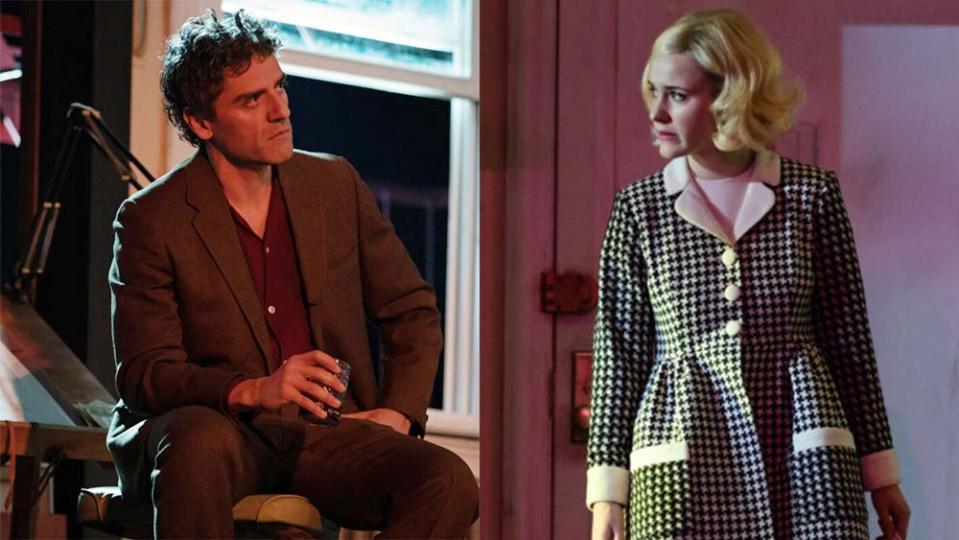
In fairness to a younger Kaufmann — who worked with Gresham for 12 years on bringing The Sign to the stage — there are arguably still many people who are not quite ready to handle Hansberry’s complex and radical production. The three-hour exploration of politics, activism, marriage, sexuality, gender, race and class set in the midst of civil, political and social unrest in the U.S. was the second and last of the late playwright’s to be mounted on a Broadway stage before her death in 1965 at the age of 34 from pancreatic cancer. The play is a story that is perhaps as relevant — and confounding to critics — as it was in its Broadway debut nearly 60 years ago.
“There was some criticism when it came out to the effect of, ‘Stay in your lane. We loved A Raisin In the Sun. Keep writing things about what you know,'” Rachel Brosnahan, who plays Iris, tells THR. “The thing about this play is that these are all people that Lorraine knew. She herself lived in the village in the 1960s. It’s a very observational play in that regard, and deeply personal.”
***
At the time The Sign first debuted in the fall of 1964, it was an anticipated — if hastily produced — follow-up to Hansberry’s industry-shifting debut. “It was a new kind of theater or new generation that A Raisin in the Sun built in 1959 when it brought busloads of Black people and created a truly integrated audience for the first time on Broadway,” says Gresham.
But by the time audiences, and particularly white critics, caught on to her brilliance with Raisin, Hansberry had already begun to build a diverse catalog of work that spanned beyond the story about three generations of a Black American family living on the Southside of Chicago. In fact, the late artist, activist and close friend of fellow literary great James Baldwin was writing A Raisin in the Sun, The Sign in Sidney Brustein’s Window, Les Blanc, an opera titled Toussaint, alongside fiction, essays and political speeches — all at the same time.
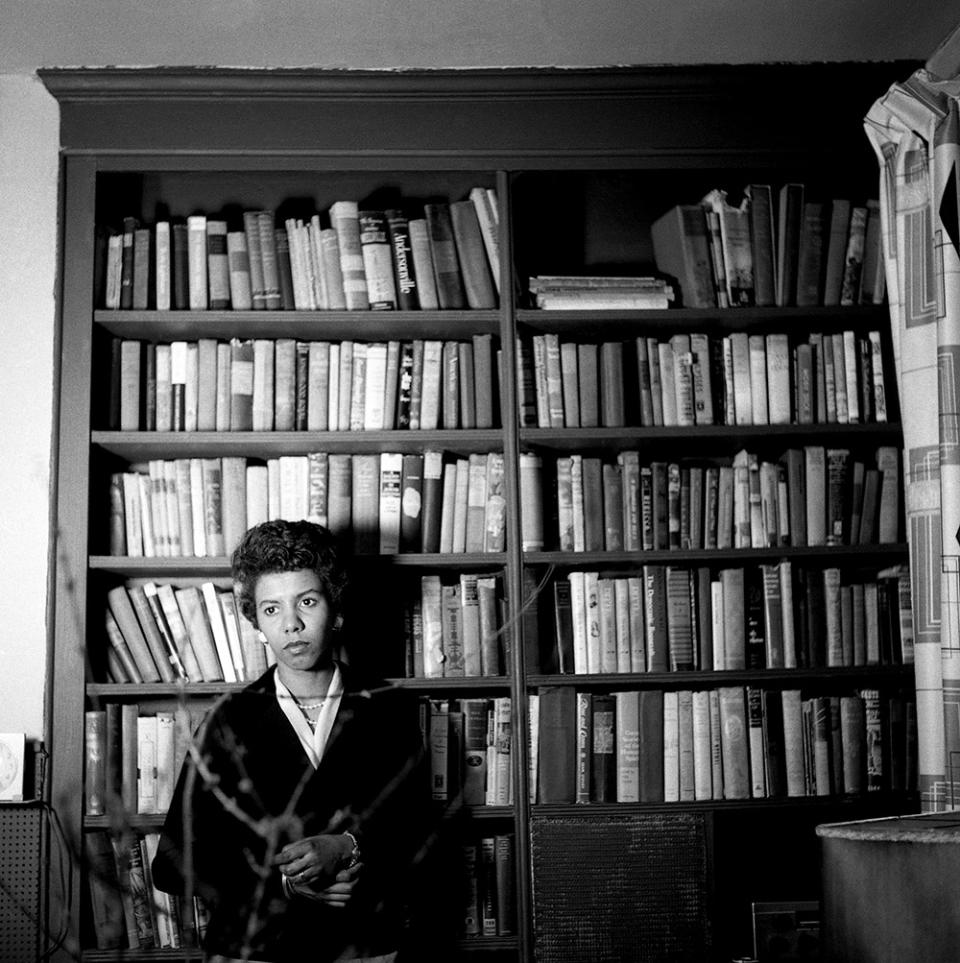
“A Raisin in the Sun was kind of this exotic historical space where these little characters were sort of like captives to a certain mindset in a historical and political situation. The Sign isn’t like that,” Gresham says. “It was written as a response to A Raisin in the Sun and the way it was received. It was written as a Freedom Act. It was written as a radical act. It was really just her on her deathbed, holding nothing back. This is political action. This is the best use of my name and my platform.”
By the spring of 1959, when her memorable Vogue magazine interview was published, “she was bored with A Raisin in the Sun,” Gresham says. “She said that was my first play, it was an experiment. I’m thrilled as hell that it’s gotten this much attention and people love it, but I’ve moved on.”
“[The Sign in Sidney Brustein’s Window] is a conversation I want to have about insurgency and American liberalism, and a challenge to the white liberal to go from being liberal to radical,” she continues.
Her first big piece had also become a Frankenstein-like horror, according to the Lorraine Hansberry Literary Trust director and daughter of Hansberry’s ex-husband, Robert Nemiroff, from his second marriage.
“That formula was set up — or so we thought — that Lorraine Hansberry was delivering for us a production that told the truth about the lives of Black people on the stage in the setting of the drama for the first time. As part of that, it ushered in a new way of white people participating in watching the Black experience,” she says of A Raisin‘s potential. “No sooner was the ink dry, Lorraine was seeing that not only was the white audience and the white critic made the lead authority, but they were a new authority as to what she was going write.”
That reception to A Raisin in the Sun is in part why The Sign‘s initial criticisms were anticipated by the artist and activist then, and Gresham says, before adding that the show’s mixed reviews from its 60 performances at the Brooklyn Academy of Music and now a 10-week limited Broadway run are also not surprising.
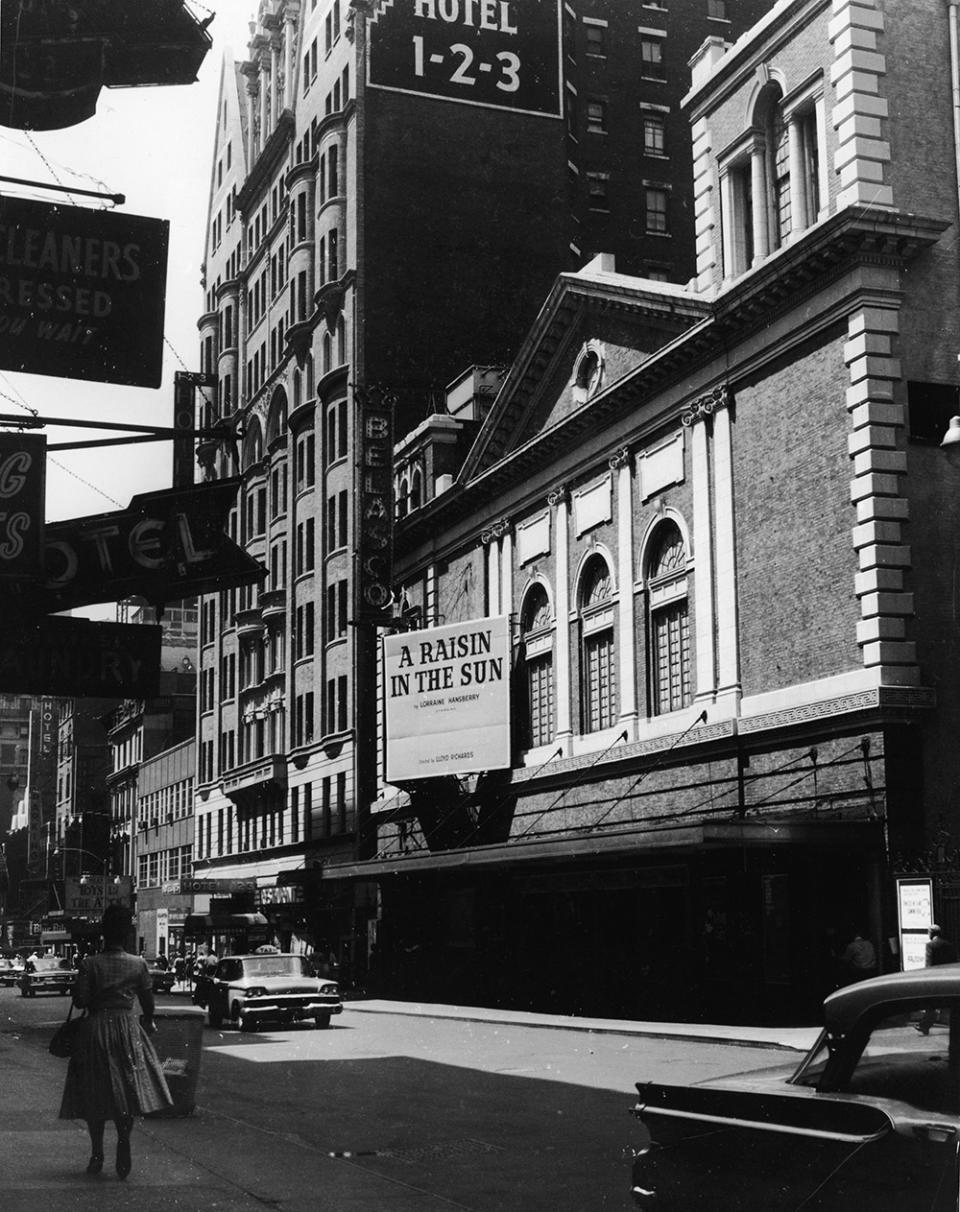
“She was not expecting critical reception to be particularly intelligent, educated, and, even more so, honest,” says Gresham. “She was not surprised, as far as I know, with the mixed reviews on Sign, and she was stunning and brilliant in her assessment and analysis of the reception of A Raisin in the Sun. Very critical of it.”
“It was a reaction to the universal love of A Raisin in the Sun and that kind of annoying element of that, meaning that this is too easily digestible,” Oscar Isaac, who portrays Sidney Brustein, adds. “Even in the play, she kind of pokes fun at uptown drama, so she’s just anti-establishment. She above all was a nonconformist, even within all of the groups and the communities that she was a part of.”
***
Beginning around 1963, Hansberry would begin experiencing a series of ailments that would see her undergo surgery, treatment and eventual hospitalization for pancreatic cancer. When a community of theater-makers, including Nemiroff, Mike Nichols and Mel Brooks, rallied around Hansberry to get what would ultimately be her final Broadway production to the stage — and then rallied the entire industry again to finance an extension that only carried the play through its Jan. 10, 1965 closing — she was in the last months of her life.
Gresham says Hansberry was not around much for the actual production, with star Isaac and other cast and creative team members learning early during the Broadway run that she appeared at one rehearsal before its opening. There, Rita Moreno — who recalled this interaction to Isaac in a text message and played the role of Iris in the play’s 1964 staging — got limited time to talk to the playwright. Hansberry’s lone message to the actress eager to understand the writer’s intentions for her character, was simple but profound: sometimes people simply occupy that kind of chaos.
While Hansberry had arguably less time and more tense conditions to work than other writers, the show’s team argues it does not lack clarity. The New York Public Library — which houses Hansberry’s works, letters and more — also documents a notable revision process, which was harried but certainly happening.
The show, including in its revival form, has faced criticism around its readiness for the stage. But members of its revival team say it is driven by a fundamental misunderstanding — or even rejection — of how a queer Black woman from the Village could write a story not led by someone who looks like her. It’s a question that has arisen much more in modern conversation around storytelling, though still not asked equally of white artists.
“I say all the time that there’s a lot of anxiety that was thrown at me in my own work because I went to Broadway. I think for some people, it feels like it’s about the fact of the work, but it’s actually about how big the work got — what architecture surrounded the work made people wonder who the work was for. It completely denied the fact that I write fully and completely for myself,” Sign producer and Tony-winning playwright Jeremy O. Harris says. “I write for myself in the sense that each time I render a new character on the page, I’m rendering a different part of my psyche that I don’t fully understand yet. And by the time I get through an arc and see how they do or don’t change by the circumstances I put them in, I get to know something new about how I see myself.”
Understanding Hansberry through this lens helps disengage her works from the historical treatment of Black playwrights who have been told to write about what “they know.” And what Hansberry knows, O. Harris tells THR, is much broader than the singular Black, queer or even female experience. It is all of that and more, giving her the ability to render the people who she’s brushed shoulders with or observed at a dinner table or in a theater, and “point to the wildly fastidious ways in which you can be brushed aside by society at large.”
“That,” he adds, “gives you the ability to see society for what it truly is.”
She’s also engaging with a kind of experience and storytelling that, historically, O. Harris notes, only white writers have been celebrated — and remembered — for. As A Raisin in the Sun provided audiences with a look into the interior lives of Black Americans, The Sign takes Hansberry’s various identities and sets them squarely within the walls of white liberalism in 1960s New York.
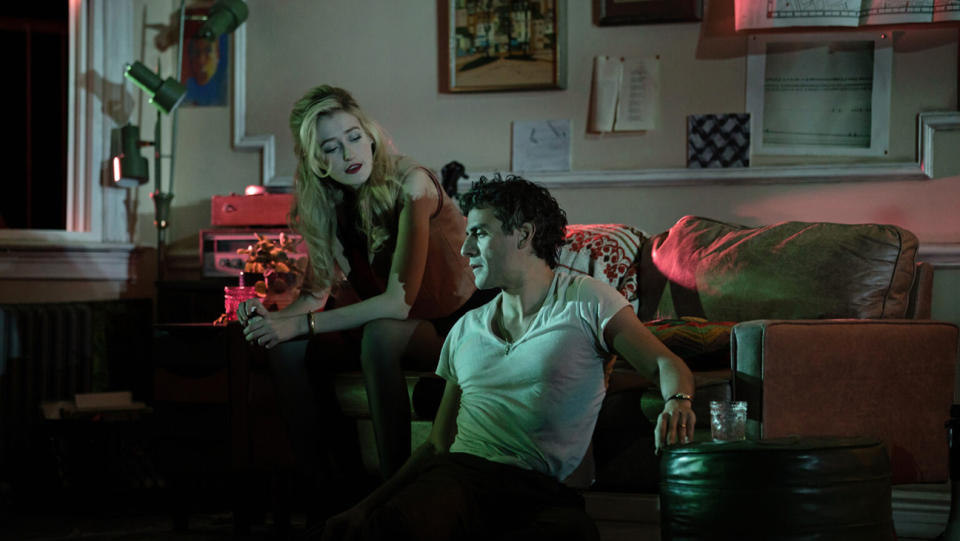
“I think Lorraine suffered from compartmentalism in her communities and segregation — which was real and it might have at times been self-imposed. She kept her communities really tight and kind of separate, and I think suffered the most in terms of her queer community because she surrounded herself intentionally by the types of white women who could not really engage her fully,” Gresham says of Hansberry’s journey with her own identity.
“She wrote a lot about selective shopping,” she continues. “‘I hang out with her for this. I hang out with her for this.’ It’s confused, and it has to do with being a queer woman and longing for choice, which is a good thing. But it becomes complicated because it brings out dark places that lead her to depression and feeling lonely and like an outsider.”
“American modernist novel writing allowed a lot of white people to explore the mess and entanglement of [identifying in a place where you were not the majority],” says O. Harris. “A lot of Black writers were doing that in the ’60s and ’70s, and doing it better than a lot of the white writers that were trying to do the same. But we don’t remember them because they don’t get brought back to Broadway. They don’t get put on a reading list with the same ferociousness that we put [William] Faulkner on one.”
***
“The Sign in Sidney Brustein’s Window is a very fascinating work because it was based on Lorraine’s relationship with her friend, a freelance photographer Gin Briggs, who lived in the village and who was staffed at The Village Voice,” Gresham tells THR.
A personal photographer to Hansberry, Briggs was the prototype for Sidney Brustein. Neither apolitical nor a radical, Gresham describes her as more of a liberal, “just doing her job within her life.” That changed when one day she was asked to put a sign in her window for someone who was running for a district political position.
“She kind of innocently did so and as a result, she was threatened by like a local mob — all kinds of people who put on the heat telling her to take that sign down, including her landlady who was saying she was going to evict her if she didn’t,” says Gresham. “That radicalized her at that moment.”
In letters, the two would discuss this. Then, over four to five drafts, a play titled first for a sign in the window of characters named Ginny and then Norman would eventually come to focus on Sidney Brustein. In that time, the play also expands from a story about local New York politics, the mob and the ethnic makeup of the West Village to something more about artists, broader intellectualism and what was going on in a marriage.
“It starts with something that was really about feminism and this female center, and it became more about this male center, who was encircled by a chorus of three sisters, who represented an analysis of patriarchy,” Gresham says.
Like the other conversations Hansberry is having with her various communities each time characters from them walk in and out of Sidney’s apartment door — Black, gay, female, activist, artist, even Jewish like her ex-husband Nemiroff — this one manifests through Iris’ family. A monologue about their last name changing to “Parados,” a Greek term used to describe the entrance ways that chorus members used to make their way to the stage, illustrates how these women serve as just one of the show’s meta commentators. “The sisters are there to tell the story or represent the story of crisis and what’s going on here,” Gresham adds.
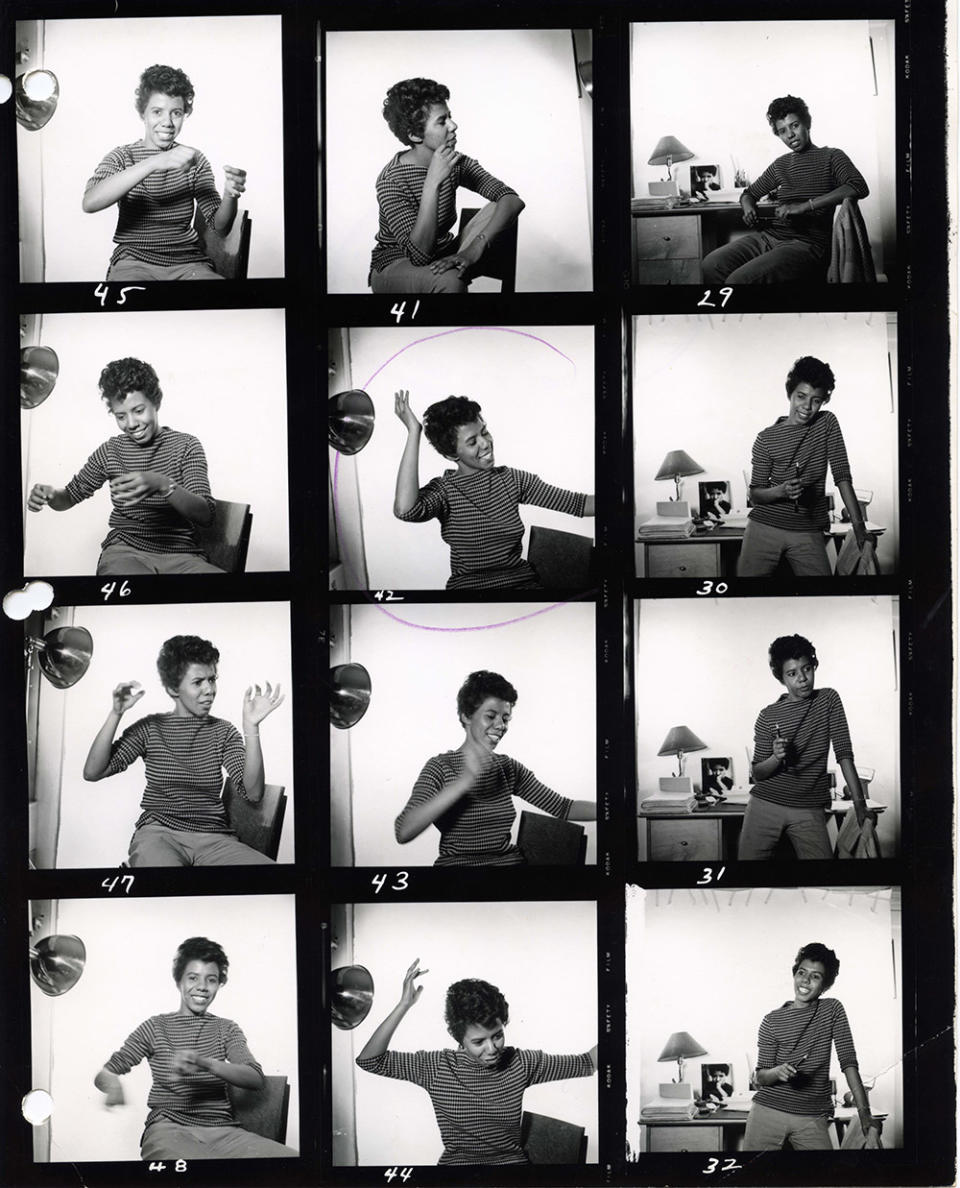
Frequently, Kaufman says, viewers have tried to identify the character that represents Hansberry, with being the one in her experience most pointed to. (Most literally, there was a Black female character and one of Sidney’s artist friends named Lydia, played by Tina Sattin, before she was cut ahead of the play’s original opening.) While Brosnahan notes that the cast learned “Lorraine had a particular fascination with the vulnerability of white women, and that feels extremely embedded in Iris — that it’s a privilege to be that vulnerable in a way that perhaps she felt that she wasn’t able to be,” Kaufman says the playwright speckles elements of her relationships, politics, beliefs, identities, losses emotional and physical in all of the characters.
“This is an act of criticism. A lot of people and I thought, too, early on, that she was Iris under her Jewish husband’s thumb. But in fact, she’s Sidney,” the director explains. “She says, ‘I’m questioning my own commitment, and I’m blind in places.’ She’s all of them, and I love exploding the idea that this is a one-to-one comparison.”
“This play talks about living in community. It’s also this romantic frame. It’s about love and betrayal, and then it politicizes that. So just when you think it’s about Sidney and Iris, then it’s about Alton and Sidney, then Alton and Gloria. It’s about Wally and Sidney,” Gresham says. “This production is the story of Sidney’s losses. Not so much the weight of his loss, but his relationship to loss and losing, which just expands and expands. He’s really struggling because everybody’s teaching him about loss, and he’s enraged by it.”
“Everybody has a lived reality and a wisdom and boundaries around it — a way of containing themselves and raging about it — and Sidney is fighting it all the way,” she adds.
That reinforces that Lorraine is telling her own story up until its (and her) very end, while teaching audiences to bear political “witness” to the losses and times of her characters, a concept incredibly important to Hansberry, Kaufman notes.
“The context feels important, the kinds of conversations that she was having with herself, and with the world at large while she was writing it feel important. Everyone is indicted by Lorraine in this play, and deservingly so,” says Brosnahan. “So it’s been important both to fight for every character’s point of view, because they reflect a part of Lorraine’s own questioning about the world around her.”
“Not only is she in her lane, but she’s leading us into a new place. She’s showing, once again, the historical moment, and because her theater is a radical platform, she’s showing us our choices. She’s showing us what we need to engage in,” Greshman says. “What we need to witness and what we need to consider — nudging us to take action from that place that was given to us, not for entertainment purposes, but to enlist us in commitment.”
***
Kaufman and Gresham have been committed to bringing this work of Hansberry’s to the stage for more than a decade, the culmination of which was to be its sold out run at BAM.
“BAM has always been my dream,” Kaufman tells THR. “I’ve been working with [BAM’s] David Binder on this for a very long time and so when he became artistic director, he was like, ‘Now we’re going to do it.’ I thought, ‘Oh, my God, this is so amazing because BAM in Brooklyn feels like the West Village of the 21st Century in a way.'”
While BAM offered a platform, the director’s journey truly began at NYU between 2006 and 2007. That’s when she started her “crusade of trying to get this piece done,” first in New York, then with someone in California and then back to New York. That was across 15 to 18 years. “Now I’m in my 50s and every time I’ve come back to it, trying to convince someone to do it, a different layer of it exposes itself to me just because I’m in a different place,” she says.
For Gresham, there was first the mounting of a 50th-anniversary revival in 2014 with the Oregon Shakespeare Festival. In 2009, she got a call from the festival’s AD, dramaturge and literary director, asking for permission to produce the play. “I said, I’ll give you the rights if you let me be part of the dramaturgical team, and we do a deep dive into the four versions of this play that Lorraine wrote and really honor Lorraine by fully reviving this,” she recalls.
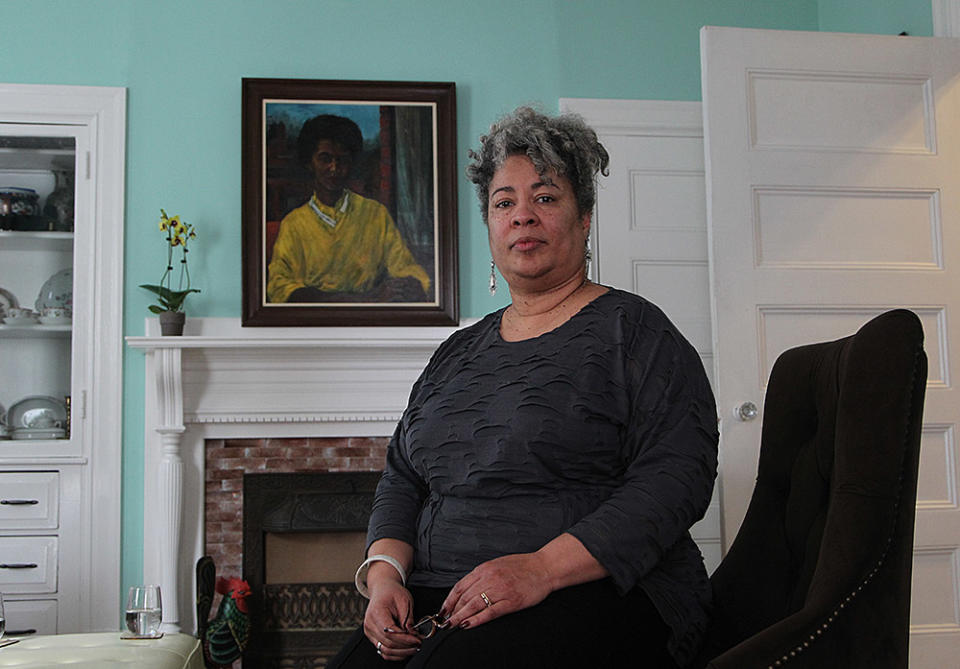
She worked with Juliette Carrillo, Chicana activist and director, and then artistic director Lue Douthit to deliver what the Hansberry Literary Trust director calls a Shakespearean folio study “to track the decisions Lorraine was making and to begin to understand contextually in history in terms of the movements that are going on and what she was doing is play.”
“The question is always, ‘What is she doing here?'” she adds. “Because she’s doing so many things.”
After would be BAM, where the production teamed with dramaturge Arminda Thomas of Classix. Launched by director Awoye Timpo in 2017, the group works to “explode the classical canon through an exploration of Black performance history and dramatic works by Black writers.” One of them, Kaufman says, is a librarian at the Schomburg, the NYPL research center in Harlem which houses Hansberry’s personal papers, diaries, manuscripts and photographs.
Since becoming director of the Hansberry trust following her mother’s passing, Gresham says that special collection has helped her shape her relationship to preserving and perpetuating the playwright’s legacy through a larger 15-year endeavor known as the Lorraine Hansberry Restoration Project. As Gresham became a gateway to Hansberry’s restricted materials, her communication wtih researchers would help her not only learn more about Lorraine, but further that knowledge beyond the research center.
“Hansberry left a seemingly apparently small body of work, about five or six published plays. But in reality, A Raisin in the Sun is being produced in 30 to 40 different languages somewhere in the world every day in a church basement, a university, a regional theater and on Broadway. The same can be said to some extent for some of her other major works with print, audio, television, film. It’s a full-time job,” she tells THR. “So I summoned my father to teach me how to work with productions and to make some of the decisions in editing and in consultation that allowed me to really dramaturgically learn from and engage Lorraine as we would think of her evolving over time.”
One result of this is her more than a decade of work with Kaufman, resulting in a 2016 production in Chicago where the director said Gresham’s presence was less intimate than BAM, where Gresham says she built a deep relationship with the cast and production. It was also in Brooklyn where, at one point, a season of Hansberry was envisioned. It would have included Robert O’Hara’s A Raisin in the Sun, Yaël Farber’s Les Blancs and Kaufman’s The Sign in Sidney Brustein’s Window, with The Sign first and ending with A Raisin “to turn the bottle upside down.”
“You’d get to see the themes and the dramaturgical structures Lorraine was creating from the historical lenses that she was operating from. These stories are global, but they’re very specific. The power of the universal, which Lorraine always talked about, is in the specific,” Gresham says. “Critics and audiences think [The Sign in Sidney Brustein’s Window] is completely contrary or dissonant with the Southside of Chicago in 1959. They don’t realize that, if you look especially at those two plays, it’s stunning how parallel they are.”
“That’s not a mistake,” she continues. “She’s saying some specific things.”
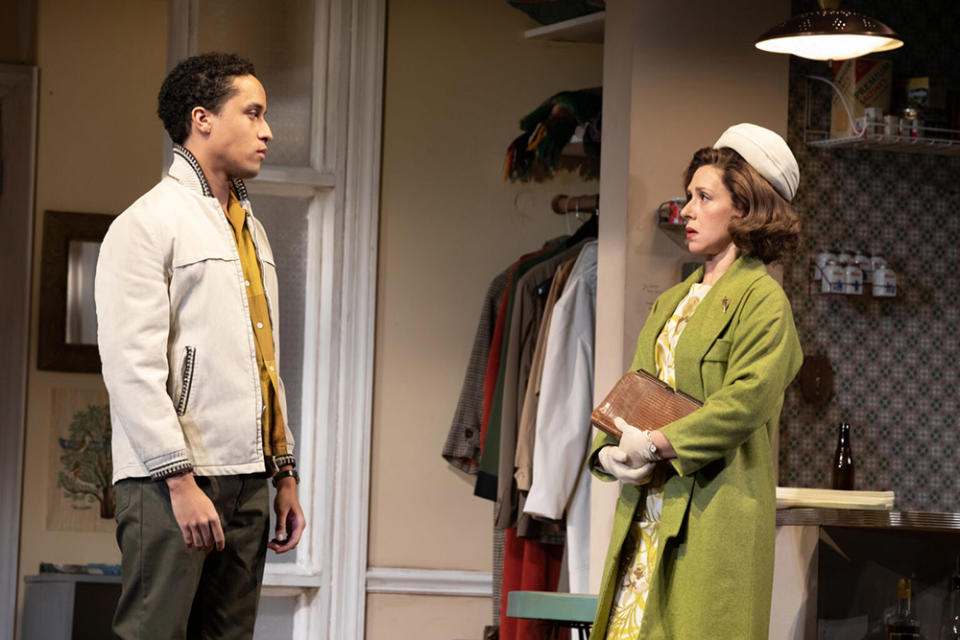
***
The Sign in Sidney Brustein’s Window arrived at the James Earl Jones Theatre in late April after a 60-performance sold-out run in Brooklyn. The production marks the first major revival of the play on Broadway and, inadvertently, became somewhat of a full circle moment for the show and Hansberry herself.
The journey to Broadway, however, was not planned. Instead, Gresham, the creative team and cast tell The Hollywood Reporter it was a mix of fate and opportunity. The production was not in the queue to appear at the theater, but another production had its financing fall through, creating a limited window for The Sign to return to Broadway. Three days before the BAM run was set to end, she got a call from her agent at WME asking about a possible transfer.
“We had the opportunity to move forward, and the only reason we did wasn’t because we’re better or we’re on higher ground. The only reason we could was because of timing and the fact that we were ready to just move the next day. On our schedule of closing down at BAM and their schedule at the theater. We were the only production on the planet that could do this,” Gresham says.
Kaufman readily credits the seed of the possibility to Isaac, who wondered aloud one day how the production might look staged for Broadway. “I really couldn’t believe it. When people were talking about it, I was just like, ‘There’s no way. There’s no way. There’s too much that has to line up,’ and then the thing lined up perfectly,” Kaufman says.
“Annie’s like, ‘This is your fault,’ because she remembers there was one performance afterward where there’s a scene where I’m laying on the couch for a while, and I was laying there being like, ‘If we did transfer, I wonder what things we could cut? How can we shave it down a little bit?’ I went over and told her this and now it happened,” Isaac recalls. “The possibility opened up for me, but it wasn’t a willed thing, and I think that’s what makes it so beautiful. And that’s what I think it’s in line with the nature and the energy of the play itself.”
While maybe not willed, there was at least a passionate want, particularly after the BAM run had been met with a disappointing wave of less-than-positive reviews, similar to those the play had been met with when it originally opened. One day, while Brosnahan was texting O. Harris, she asked whether he was going to come to the BAM run. Their interaction ultimately triggered a sequence of events that put the show on the Broadway stage.
“We were texting about whether or not he was going to get a chance to see the show, and I shot him a text and asked, ‘Are you coming?’ He said he was out of town, but went, ‘Tell me there’s another life for this?'” the actress recalled. “There was some rumblings, but they were pretty quiet at that point. I said, ‘I’m not sure. I don’t think so.’ He texted me and said, ‘I’m making some calls. Be right back.'”
Shortly thereafter, she says, the “magic of Jeremy O. Harris” had rallied troops. The playwright humbly accepts less responsibility. O. Harris was at the time in Italy, mentoring several playwrights amid a residency tied to the Yale Drama Series prize and Gucci, when he got the message from Brosnahan. At that point, he called up John Johnson, Sue Wagner and Greg Nobile — “producers that have worked in this manner, with much, much bigger resumes than I have” — to partner on the effort.
“I said who are the three craziest producers I know,” O. Harris tells THR. “They ran the numbers, and then they reached out to Joi, and I ended up in my spare time producing a play on Broadway, with gracious and intelligent partners who were brave and the reason this happened the way it did.”
The show’s team has given Hansberry’s play a repeated welcoming with opening parties, intimate celebrations with notable Broadway names as well as efforts designed to “pass the hat” to young playwrights, working towards enshrining her legacy beyond A Raisin in the Sun off-stage while Hansberry’s The Sign prods audiences on stage.
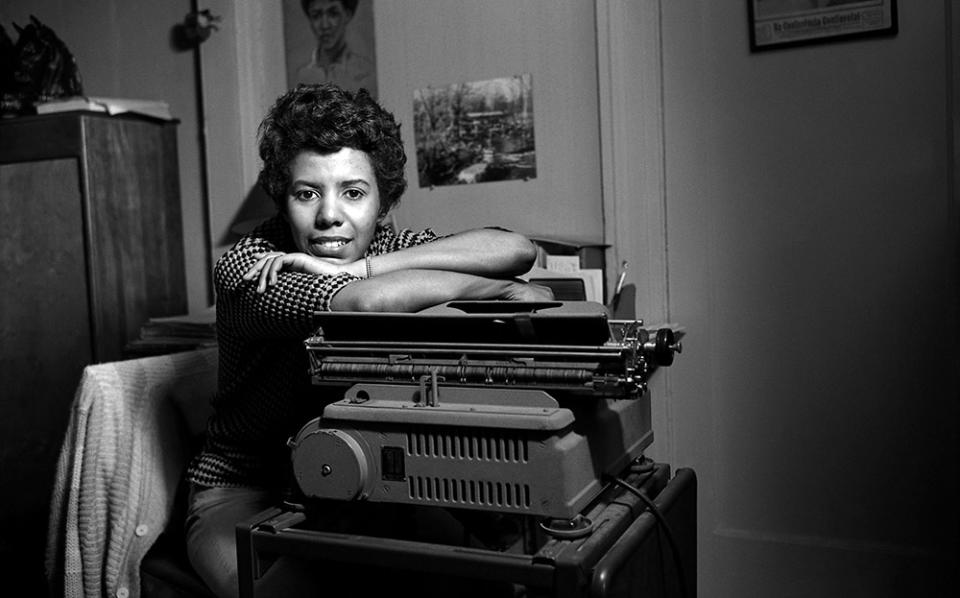
It was an effort Kaufman likens to the first attempt to stage The Sign on Broadway. “That’s why I feel Lorraine and all of the spirit around this piece,” she says. “The history of this is all of these artists rallied to get this play to continue playing beyond the critics, beyond the run, and I kind of feel like that’s what happened this time.”
***
Nominated for multiple Tonys, including best revival of a play, and running on Broadway through July 2, Isaac notes The Sign is one of the longest periods of time he’s ever spent with a single stage character. It’s a time that, for the entirety of the show’s back-to-back runs, has also seen a country facing down its social ills amid fights for rights and justice — a clear echo, Gresham says, of the U.S. Hansberry lived in during the 1960s.
It’s also been met with some criticism — another oddly full circle moment for its Broadway return — with O. Harris noting that critiques about clarity or length (the show did lose a few minutes in its transfer to Broadway) are not lobbed at other famed plays equally. The Sign, he says, is “not anywhere near as messy as” something like All My Sons,” with the “legibility” of Arthur Miller’s play not brought into question the same way. The same can be said of The Crucible, which O. Harris loves, but says “the need for cutting in that play is immense.”
“When you’re confrontational and femme and Black, oftentimes, people would rather say they don’t understand you, even when you’re speaking plain English,” he notes. “I think that one of the things that’s really exhilarating about [Hansberry’s] voice, specifically, is in that classic way that so many women in my life can have the loudest voice in the room without needing to pick up a microphone, that’s what it feels like when you sit here. Sidney wales and yells, and yet, the voice that’s carrying Sidney’s voice is almost speaking at not a whisper, but something just above it. And you’re hearing it deeply if it’s a voice you want to pay attention to.”
What the play doesn’t have in the same way as its original run is that its criticism can be met with a new set of voices — artists and audiences who resemble Lorraine and beyond. Now, “the reviews aren’t the measure, they’re not the recognition,” according to Gresham. Instead, they’re a temperature taking “in terms of resistance, in terms of cognitive dissonance, to radical action.”
“There’s a wild, dark freedom, in particular, in this play that interestingly enough — just from reading the old reviews — seems like it hasn’t lost any of its power to provoke and to make people feel uncomfortable,” Isaac says. “I think sometimes that reaction is to dismiss it. I think there’s something about it that gets under your skin, and for me, there is something incredibly elementally explosive about the way that she approaches these characters and the things they say, and the kind of unbridled energy that she allows to be released.”
For Brosnahan, people can respond to that energy now more than before on their own individual terms, and, in her experience, have been.
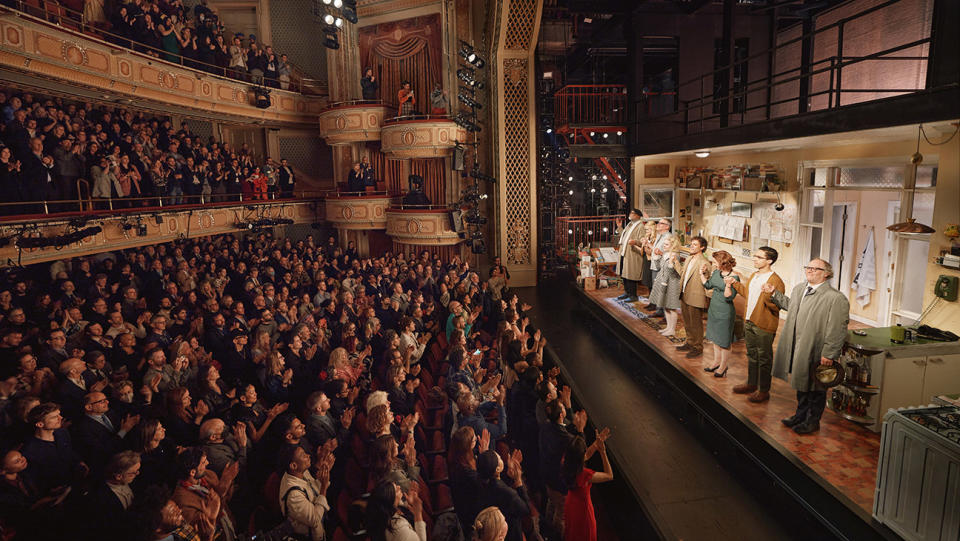
“Just like we hear different questions coming through different characters every night, or different lines that stand out to us, that seems to be the experience of the audience, too,” she says. “Lorraine talked a lot about the purpose of art being to give people an experience, but also to move people, and one of her primary frustrations when she wrote this play — one of many — was that her fellow playwrights were giving over to despair. It feels like through this play, she’s making space for a lot of different people of different experiences to be all of themselves on stage.”
“We through her are asking audiences to be moved to something big or small, and that feels like a powerful responsibility, but also one that lives outside of any kind of critical response,” she adds.
Yet perhaps the biggest achievement of Hansberry’s return — under whatever conditions it is met — is how it makes space for a kind of historically marginalized voice that O. Harris says gives permission to others to make art in the same way.
“Some of the ways in which activism works — because you have to say something very specific and to the point in order to get people to understand it, much like Sidney does throughout the play — it has a limiting factor. So it can make a young black, queer woman feel like the only work that she should be writing right now, whether she wants to or not, is work that is actively some sense of self-portraiture,” he says. “Seeing something like The Sign in Sidney Brustein’s Window, which is just as much a portrait of Lorraine as A Raisin in the Sun was, feels really important to me, because it allows a young audience to say I can write anything.”
Its return to Broadway also puts the work in the canon alongside other greats, where it can be accessed by a new generation alongside other Black
“Especially for a lot of young people of color, there does feel the sense that there’s only one thing that they should be writing or can be writing. I don’t want to live in or be watching culture over the next decade that feels like that,” O. Harris continues. “You can write Ohio State Murders, and turn around and write The Sign in Sidney Brustein’s Window. And with both of those plays on Broadway, both might end up in the rubric of a Minnesota high school drama program’s reading lists if some horrifically racist, homophobic lawmaker doesn’t put them on a banned book list. That’s what excites me.”
Best of The Hollywood Reporter
